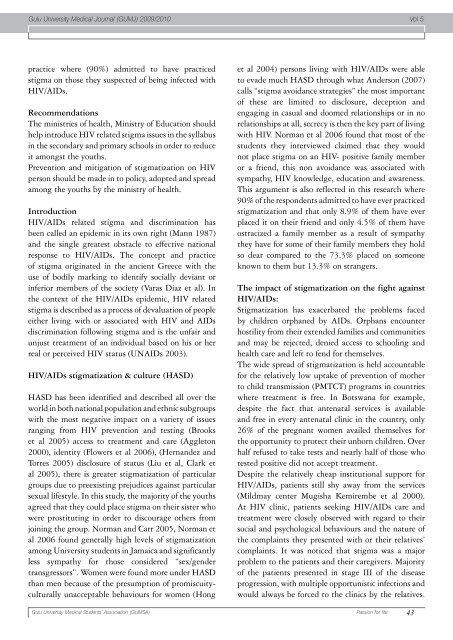GULU UNIVERSITY MEDICAL JOURNAL
GULU UNIVERSITY MEDICAL JOURNAL
GULU UNIVERSITY MEDICAL JOURNAL
You also want an ePaper? Increase the reach of your titles
YUMPU automatically turns print PDFs into web optimized ePapers that Google loves.
Gulu University Medical Journal (GUMJ) 2009/2010 Vol 5.<br />
practice where (90%) admitted to have practiced<br />
stigma on those they suspected of being infected with<br />
HIV/AIDs.<br />
Recommendations<br />
The ministries of health, Ministry of Education should<br />
help introduce HIV related stigma issues in the syllabus<br />
in the secondary and primary schools in order to reduce<br />
it amongst the youths.<br />
Prevention and mitigation of stigmatization on HIV<br />
person should be made in to policy, adopted and spread<br />
among the youths by the ministry of health.<br />
Introduction<br />
HIV/AIDs related stigma and discrimination has<br />
been called an epidemic in its own right (Mann 1987)<br />
and the single greatest obstacle to effective national<br />
response to HIV/AIDs. The concept and practice<br />
of stigma originated in the ancient Greece with the<br />
use of bodily marking to identify socially deviant or<br />
inferior members of the society (Varas Diaz et al). In<br />
the context of the HIV/AIDs epidemic, HIV related<br />
stigma is described as a process of devaluation of people<br />
either living with or associated with HIV and AIDs<br />
discrimination following stigma and is the unfair and<br />
unjust treatment of an individual based on his or her<br />
real or perceived HIV status (UNAIDs 2003).<br />
HIV/AIDs stigmatization & culture (HASD)<br />
HASD has been identified and described all over the<br />
world in both national population and ethnic subgroups<br />
with the most negative impact on a variety of issues<br />
ranging from HIV prevention and testing (Brooks<br />
et al 2005) access to treatment and care (Aggleton<br />
2000), identity (Flowers et al 2006), (Hernandez and<br />
Torres 2005) disclosure of status (Liu et al, Clark et<br />
al 2005), there is greater stigmatization of particular<br />
groups due to preexisting prejudices against particular<br />
sexual lifestyle. In this study, the majority of the youths<br />
agreed that they could place stigma on their sister who<br />
were prostituting in order to discourage others from<br />
joining the group. Norman and Carr 2005, Norman et<br />
al 2006 found generally high levels of stigmatization<br />
among University students in Jamaica and significantly<br />
less sympathy for those considered “sex/gender<br />
transgressors”. Women were found more under HASD<br />
than men because of the presumption of promiscuityculturally<br />
unacceptable behaviours for women (Hong<br />
et al 2004) persons living with HIV/AIDs were able<br />
to evade much HASD through what Anderson (2007)<br />
calls “stigma avoidance strategies” the most important<br />
of these are limited to disclosure, deception and<br />
engaging in casual and doomed relationships or in no<br />
relationships at all, secrecy is then the key part of living<br />
with HIV. Norman et al 2006 found that most of the<br />
students they interviewed claimed that they would<br />
not place stigma on an HIV- positive family member<br />
or a friend, this non avoidance was associated with<br />
sympathy, HIV knowledge, education and awareness.<br />
This argument is also reflected in this research where<br />
90% of the respondents admitted to have ever practiced<br />
stigmatization and that only 8.9% of them have ever<br />
placed it on their friend and only 4.5% of them have<br />
ostracized a family member as a result of sympathy<br />
they have for some of their family members they hold<br />
so dear compared to the 73.3% placed on someone<br />
known to them but 13.3% on strangers.<br />
The impact of stigmatization on the fight against<br />
HIV/AIDs:<br />
Stigmatization has exacerbated the problems faced<br />
by children orphaned by AIDs. Orphans encounter<br />
hostility from their extended families and communities<br />
and may be rejected, denied access to schooling and<br />
health care and left to fend for themselves.<br />
The wide spread of stigmatization is held accountable<br />
for the relatively low uptake of prevention of mother<br />
to child transmission (PMTCT) programs in countries<br />
where treatment is free. In Botswana for example,<br />
despite the fact that antenatal services is available<br />
and free in every antenatal clinic in the country, only<br />
26% of the pregnant women availed themselves for<br />
the opportunity to protect their unborn children. Over<br />
half refused to take tests and nearly half of those who<br />
tested positive did not accept treatment.<br />
Despite the relatively cheap institutional support for<br />
HIV/AIDs, patients still shy away from the services<br />
(Mildmay center Mugisha Kemirembe et al 2000).<br />
At HIV clinic, patients seeking HIV/AIDs care and<br />
treatment were closely observed with regard to their<br />
social and psychological behaviours and the nature of<br />
the complaints they presented with or their relatives’<br />
complaints. It was noticed that stigma was a major<br />
problem to the patients and their caregivers. Majority<br />
of the patients presented in stage III of the disease<br />
progression, with multiple opportunistic infections and<br />
would always be forced to the clinics by the relatives.<br />
Gulu University Medical Students’ Association (GUMSA) Passion for life 43


